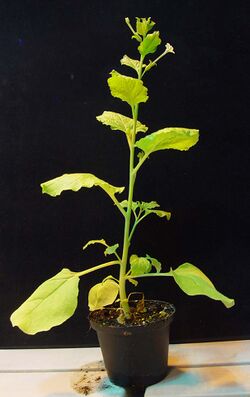Biology:Nicotiana benthamiana
| Nicotiana benthamiana | |
|---|---|

| |
| Scientific classification | |
| Kingdom: | Plantae |
| Clade: | Tracheophytes |
| Clade: | Angiosperms |
| Clade: | Eudicots |
| Clade: | Asterids |
| Order: | Solanales |
| Family: | Solanaceae |
| Genus: | Nicotiana |
| Species: | N. benthamiana
|
| Binomial name | |
| Nicotiana benthamiana Domin
| |
Nicotiana benthamiana, colloquially known as benth or benthi, is a species of Nicotiana indigenous to Australia. It is a close relative of tobacco.[1]
A synonym for this species is Nicotiana suaveolens var. cordifolia, a description given by George Bentham in Flora Australiensis in 1868. This was transferred to Nicotiana benthamiana by Karel Domin in Bibliotheca Botanica (1929), honoring the original author in the specific epithet.[2]
History
The plant was used by people of Australia as a stimulant, containing nicotine and other alkaloids, before the introduction of commercial tobacco (N. tabacum and N. rustica). Indigenous names for it include tjuntiwari and muntju. It was first collected on the north coast of Australia by Benjamin Bynoe on a voyage of HMS Beagle in 1837.[3]
Description

The herbaceous plant is found amongst rocks on hills and cliffs throughout the northern regions of Australia. Variable in height and habit, the species may be erect and up to 1.5 metres (59.1 in) or sprawling out no taller than 200 millimetres (7.9 in). The flowers are white.[4]
Research uses
N. benthamiana has been used as a model organism in plant research. For example, the leaves are rather frail and can be injured in experiments to study ethylene synthesis. Ethylene is a plant hormone which is secreted, among other situations, after injuries. Using gas chromatography, the quantity of ethylene emitted can be measured.[5] Due to the large number of plant pathogens able to infect it, N. benthamiana is widely used in the field of plant virology.[6] It is also an excellent target plant for agroinfiltration.[7]
N. benthamiana has a number of wild strains across Australia, and the laboratory strain is an extremophile originating from a population that has retained a loss-of-function mutation in Rdr1 (RNA-dependent RNA polymerase 1), rendering it hypersusceptible to viruses.[8]
Biotechnology
N. benthamiana is also a common plant used for "pharming" of monoclonal antibodies and other recombinant proteins; for example, the drug ZMapp was produced using these plants.[3]
GMO
Cocaine
In 2022, a genetically engineered N. benthamiana was developed that was able to produce 25% of the amount of cocaine found in a coca plant.[9]
COVID-19 vaccine development
The Quebec City-based biotechnology company, Medicago Inc., uses N. benthamiana as a "factory" to produce virus-like particles over short incubation periods (days) and in high volume, enabling rapid manufacturing capability for a potential COVID-19 vaccine.[10][11]
In February 2022, Health Canada authorised use of the COVID-19 vaccine called CoVLP (brand name Covifenz) developed from N. benthamiana for preventing infection in adults 18 to 64 years old.[12]
References
- ↑ Derevnina, Lida; Kamoun, Sophien; Wu, Chih‐hang (20 December 2018). "Dude, where is my mutant? Nicotiana benthamiana meets forward genetics". New Phytologist 221 (2): 607–610. doi:10.1111/nph.15521. PMID 30569612.
- ↑ "Nicotiana benthamiana". Australian Plant Name Index (APNI), IBIS database. Centre for Plant Biodiversity Research, Australian Government. http://www.anbg.gov.au/cgi-bin/apni?taxon_id=22952.
- ↑ 3.0 3.1 "How Owensboro tobacco grew a possible miracle drug to treat Ebola". Lexington Herald-Leader. 9 August 2014. https://www.kentucky.com/news/business/article44501997.html. Retrieved 5 March 2019.
- ↑ "Nicotiana benthamiana". FloraBase. Western Australian Government Department of Parks and Wildlife. https://florabase.dpaw.wa.gov.au/browse/profile/6971.
- ↑ Matsukawa, Mizuki; Shibata, Yusuke; Ohtsu, Mina; Mizutani, Aki; Mori, Hitoshi; Wang, Ping; Ojika, Makoto; Kawakita, Kazuhito et al. (August 2013). "Nicotiana benthamiana Calreticulin 3a Is Required for the Ethylene-Mediated Production of Phytoalexins and Disease Resistance Against Oomycete Pathogen Phytophthora infestans". Molecular Plant-Microbe Interactions 26 (8): 880-892. doi:10.1094/MPMI-12-12-0301-R.
- ↑ Goodin, Michael M; Zaitlin, David; Naidu, Rayapati A; Lommel, Steven A (August 2008). "Nicotiana benthamiana: its history and future as a model for plant-pathogen interactions". Molecular Plant-Microbe Interactions 21 (8): 1015-1026. doi:10.1094/MPMI-21-8-1015. PMID 18616398.
- ↑ Van der Hoorn, Renier A. L.; Laurent, Franck; Roth, Ronelle; De Wit, Pierre J. G. M. (April 2000). "Agroinfiltration Is a Versatile Tool That Facilitates Comparative Analyses of Avr9/Cf-9-Induced and Avr4/Cf-4-Induced Necrosis". Molecular Plant-Microbe Interactions 13 (4): 439–446. doi:10.1094/MPMI.2000.13.4.439. PMID 10755307.
- ↑ Bally, Julia; Nakasugi, Kenlee; Jia, Fangzhi; Jung, Hyungtaek; Ho, Simon Y.W.; Wong, Mei; Paul, Chloe M.; Naim, Fatima et al. (2 November 2015). "The extremophile Nicotiana benthamiana has traded viral defence for early vigour". Nature Plants 1 (11): 15165. doi:10.1038/nplants.2015.165. PMID 27251536.
- ↑ "Genetically modified tobacco plant produces cocaine in its leaves". https://www.newscientist.com/article/2348568-genetically-modified-tobacco-plant-produces-cocaine-in-its-leaves/.
- ↑ "Technologies: Production platform". Medicago Inc.. 2020. https://www.medicago.com/en/technologies/.
- ↑ Vishwadha Chander (2020-07-14). "Canada's Medicago begins human trials of plant-based COVID-19 vaccine". National Post (Reuters). https://nationalpost.com/news/canada/canadas-medicago-begins-human-trials-of-plant-based-covid-19-vaccine.
- ↑ "Health Canada authorizes Medicago COVID-19 vaccine for adults 18 to 64 years of age". Health Canada, Government of Canada. 24 February 2022. https://www.canada.ca/en/health-canada/news/2022/02/health-canada-authorizes-medicago-covid-19-vaccine-for-adults-18-to-64-years-of-age.html.
Wikidata ☰ Q3024956 entry
 |

